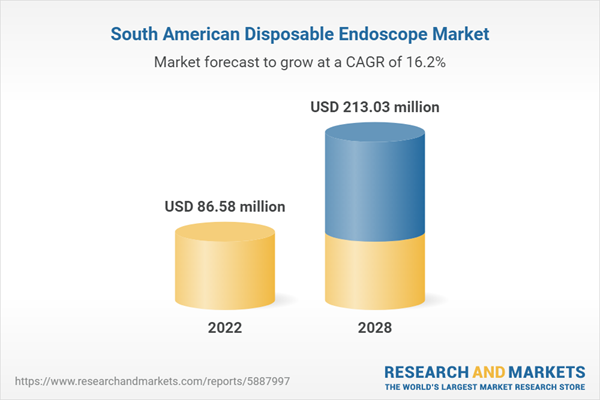The South America disposable endoscope market is expected to grow from US$ 86.58 million in 2022 to US$ 213.03 million by 2028; it is estimated to record a CAGR of 16.2% from 2022 to 2028.
Reusable endoscope in the hospital systems requires complex reprocessing equipment, including drying equipment, and trained staff. Further, reprocessing delays, equipment downtime, endoscope breaks, and staff shortages can result in procedure delays and other inefficiencies, which can negatively impact patient care. However, single-use endoscopes are sterile and easily available.
They do not require complex reprocessing infrastructure reduces both labor and capital intensity whereas reusable endoscopes are both capital- and labor-intensive. Demand for single-use endoscopes continues to grow rapidly as healthcare professionals seek high-performing and intuitive endoscopy solutions that enhance patient safety, provide tangible workflow and efficiency benefits, and incorporate the latest technology advances.
Thus, due to an increasing focus on patient safety and workflow efficiency, the South America disposable endoscope market is growing at a rapid pace.
Based on end user, the South America disposable endoscope market is segmented into hospitals, diagnostic centers, and clinics. The hospitals segment held the largest market share in 2022.
Based on country, the South America disposable endoscope market is segmented into Brazil, Argentina, and the Rest of South America. Brazil dominated the South America disposable endoscope market share in 2022.
Boston Scientific Corp; Ambu AS; Hill-Rom Services Inc.; Karl Storz SE & Co KG; Flexicare (Group) Ltd; Parburch Medical Developments Ltd; and Coloplast Corp are the leading companies operating in the South America disposable endoscope market.
Increased Focus on Patient Safety and Workflow Efficiency Bolsters Disposable Endoscope Market Growth
In recent years, there has been a growing awareness about the risk of cross-contamination due to reusable endoscopes, which can carry harmful organisms among patients. With regard to reusable endoscopy, FDA has intensified its guidelines by issuing safety communications and highlighting risks across pulmonology, urology, ENT, and gastroenterology. Furthermore, over the past few years, there has been an increase in reusable endoscope recalls and safety warnings related to endoscope use in the urology, ENT, and gastroenterology branches. The Association for the Advancement of Medical Instrumentation (AAMI) has classified pulmonology, urology, and GI endoscopes as high-risk and has put in place highly stringent cleaning guidelines, which has increased the cost and the complexity of reusable endoscopy.Reusable endoscope in the hospital systems requires complex reprocessing equipment, including drying equipment, and trained staff. Further, reprocessing delays, equipment downtime, endoscope breaks, and staff shortages can result in procedure delays and other inefficiencies, which can negatively impact patient care. However, single-use endoscopes are sterile and easily available.
They do not require complex reprocessing infrastructure reduces both labor and capital intensity whereas reusable endoscopes are both capital- and labor-intensive. Demand for single-use endoscopes continues to grow rapidly as healthcare professionals seek high-performing and intuitive endoscopy solutions that enhance patient safety, provide tangible workflow and efficiency benefits, and incorporate the latest technology advances.
Thus, due to an increasing focus on patient safety and workflow efficiency, the South America disposable endoscope market is growing at a rapid pace.
South America Disposable Endoscope Market Overview
The South America disposable endoscope market is segmented into Argentina, Brazil, and the Rest of South America. The market growth in this region is attributed to the increasing prevalence of chronic illnesses and rising government support for the disposable endoscope market.South America Disposable Endoscope Market Revenue and Forecast to 2028 (US$ Million)
South America Disposable Endoscope Market Segmentation
The South America disposable endoscope market is segmented based on application, end user, and country. Based on application, the South America disposable endoscope market is segmented into GI endoscopy, bronchoscopy, urologic endoscopy, arthroscopy, proctoscopy, and others. The GI endoscopy segment held the largest market share in 2022.Based on end user, the South America disposable endoscope market is segmented into hospitals, diagnostic centers, and clinics. The hospitals segment held the largest market share in 2022.
Based on country, the South America disposable endoscope market is segmented into Brazil, Argentina, and the Rest of South America. Brazil dominated the South America disposable endoscope market share in 2022.
Boston Scientific Corp; Ambu AS; Hill-Rom Services Inc.; Karl Storz SE & Co KG; Flexicare (Group) Ltd; Parburch Medical Developments Ltd; and Coloplast Corp are the leading companies operating in the South America disposable endoscope market.
Table of Contents
1. Introduction
3. Research Methodology
4. South America Disposable Endoscope Market - Market Landscape
5. South America Disposable Endoscope Market - Key Market Dynamics
6. Disposable Endoscope Market - South America Analysis
7. South America Disposable Endoscope Market - Revenue and Forecast to 2028 - by Application
8. South America Disposable Endoscope Market - Revenue and Forecast to 2028 - by End User
9. South America Disposable Endoscope Market - Revenue and Forecast to 2028 - by Country Analysis
10. Disposable Endoscope Market - Industry Landscape
11. Company Profiles
12. Appendix
List of Tables
List of Figure
Companies Mentioned
- Boston Scientific Corp
- Ambu AS
- Hill-Rom Services Inc.
- Karl Storz SE & Co KG
- Flexicare (Group) Ltd
- Parburch Medical Developments Ltd
- Coloplast Corp
Table Information
| Report Attribute | Details |
|---|---|
| No. of Pages | 99 |
| Published | July 2023 |
| Forecast Period | 2022 - 2028 |
| Estimated Market Value ( USD | $ 86.58 million |
| Forecasted Market Value ( USD | $ 213.03 million |
| Compound Annual Growth Rate | 16.2% |
| No. of Companies Mentioned | 7 |









